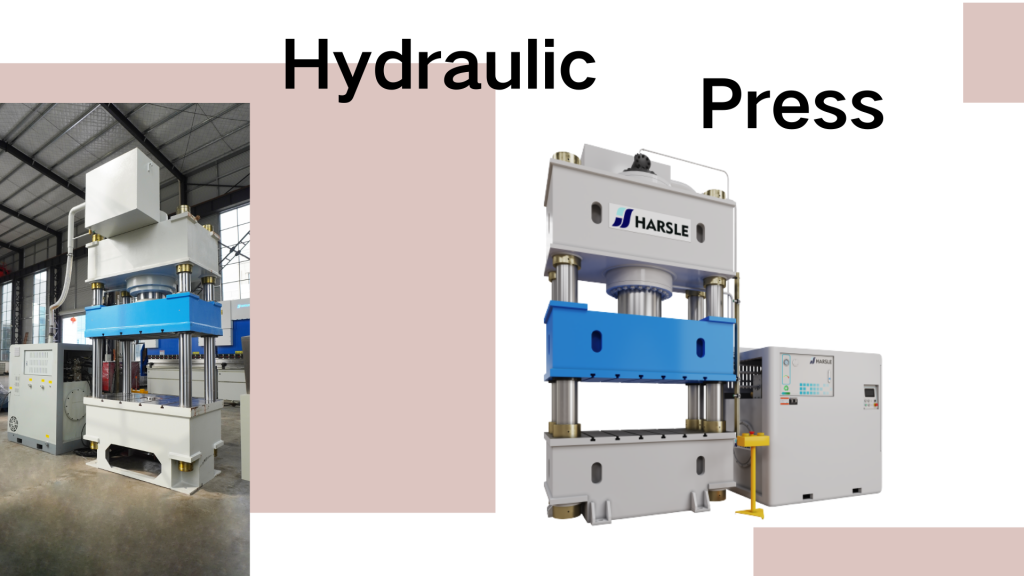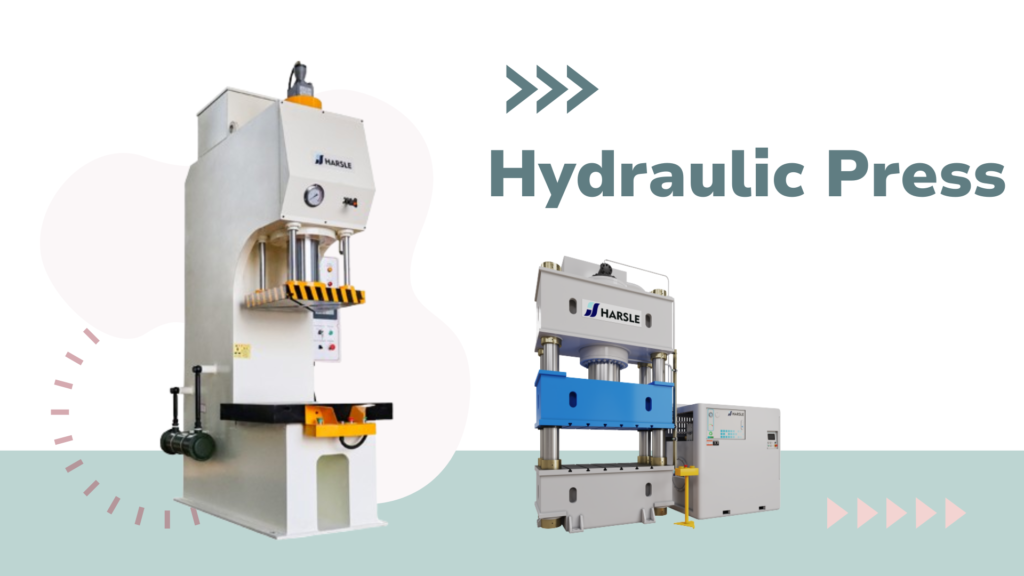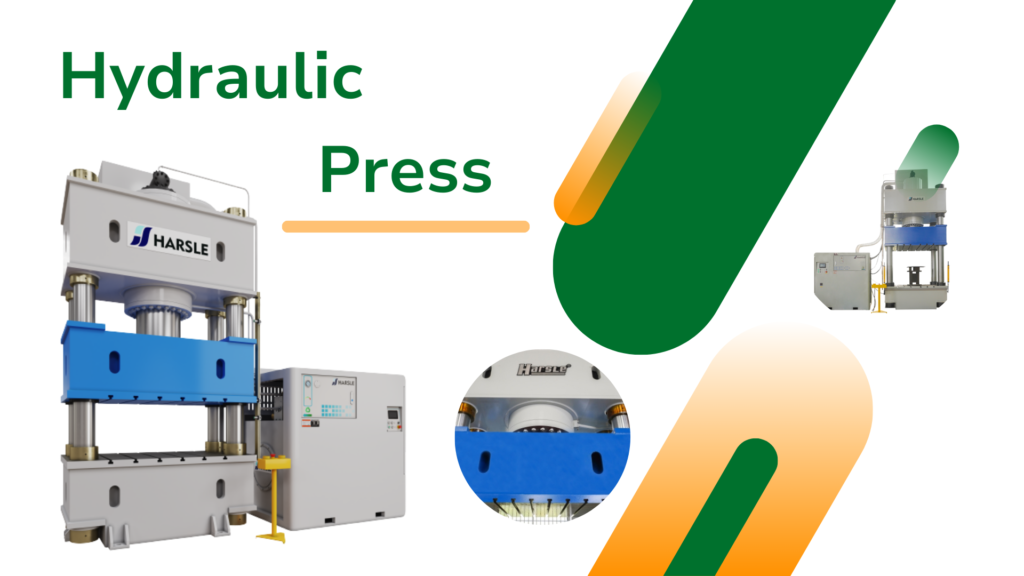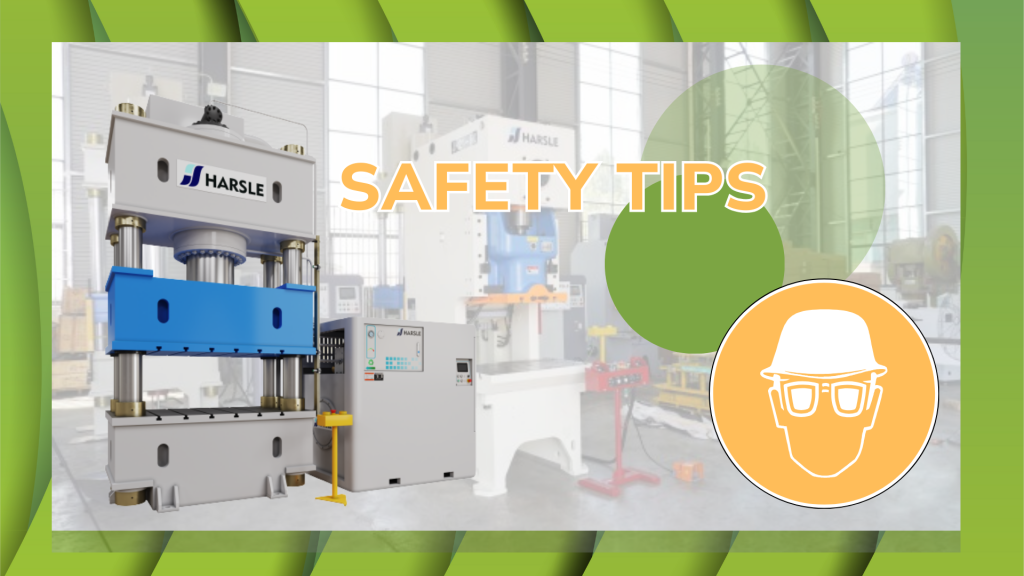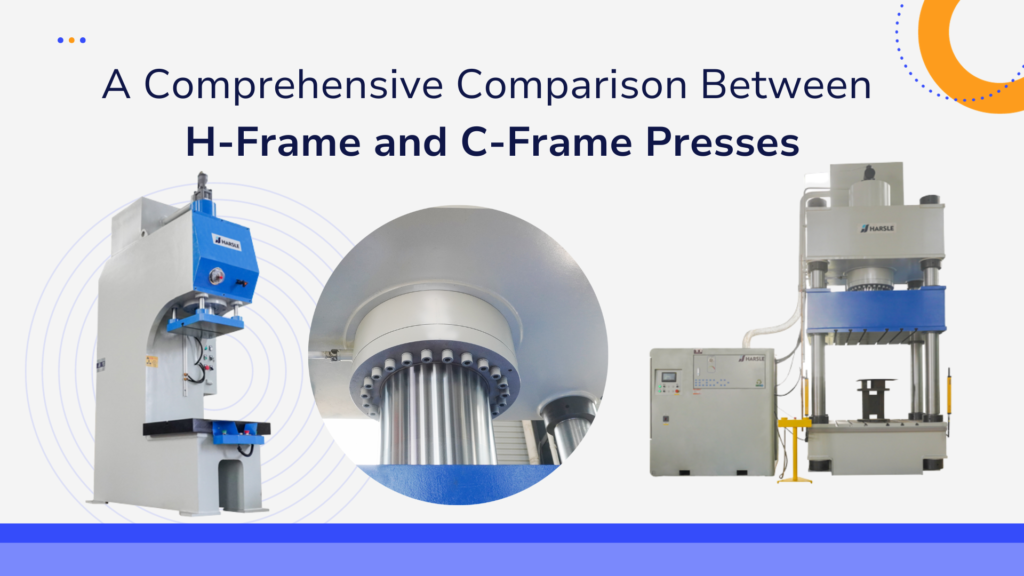34 Important Points About Hydraulic Presses

Hydraulic presses are highly important and find extensive applications across various industries due to their ability to generate and control immense force through the use of hydraulic fluid.
hydraulic presses are crucial tools in manufacturing and various other industries due to their unmatched force generation, precision, and versatility. Their applications range from shaping metals and plastics to producing composite materials, forging strong components, and even impacting areas such as woodworking and healthcare. Their importance in modern industrial processes is undeniable.
Basic Components of a Hydraulic Press
Hydraulic presses are powerful machines that leverage the principles of fluid dynamics to generate substantial force for a wide range of industrial applications. Whether it’s shaping metal, molding plastics, or compressing materials, hydraulic presses are indispensable tools in manufacturing processes. To understand how these machines work, it’s essential to delve into their basic components. In this article, we’ll explore the fundamental components of a hydraulic press and how they come together to perform a multitude of tasks.

Hydraulic System
At the heart of every hydraulic press is the hydraulic system, which consists of several key components working together to transmit force efficiently.
1. Hydraulic Fluid
Hydraulic fluid, often a specialized oil, serves as the medium that transfers force within the system. It is chosen for its ability to handle high pressure, lubricate moving parts, and resist temperature variations. Hydraulic fluid is a vital element that ensures the smooth operation of the press.
2. Hydraulic Pump
The hydraulic pump is responsible for generating the primary force within the hydraulic system. It draws in hydraulic fluid from a reservoir and pressurizes it, creating a flow of high-pressure fluid. This pressurization is what ultimately provides the force needed for various operations.
3. Hydraulic Cylinders
Hydraulic cylinders are the workhorses of the hydraulic press. These devices consist of a piston and a cylinder and are where the pressurized hydraulic fluid generates force. When pressurized fluid enters the cylinder, it pushes the piston, producing a linear force that is transmitted to the working tool or die. The size and number of cylinders can vary depending on the press’s design and intended applications.
Frame and Structure
The frame and structure of a hydraulic press provide the necessary stability and support for the hydraulic components and the work being performed. Different types of hydraulic presses, such as C-frame, H-frame, or four-column designs, have distinct frames that suit specific applications.

4. Frame
The frame is the outer structure that encases the hydraulic components. It must be rigid and sturdy to withstand the forces generated during operations. Frames are typically made from high-strength materials like steel to ensure durability.
5. Platens
Platens are flat, parallel plates mounted on hydraulic cylinders. They serve as the surface against which the workpiece is placed. The size and shape of the platens can be customized to accommodate various workpiece sizes and shapes.
Control Systems
Control systems in hydraulic presses play a pivotal role in managing the machine’s operation. They enable precise control over the force applied, speed, and timing of the hydraulic press.
6. Manual Controls
Manual control systems typically involve levers, buttons, or knobs that allow operators to regulate the press’s actions manually. While they offer direct control, they may lack the precision and repeatability of automated systems.
7. Automated Controls
Automated control systems use advanced technology, such as programmable logic controllers (PLCs) and human-machine interfaces (HMIs), to automate and fine-tune the press’s operations. This automation enhances precision, repeatability, and productivity while reducing the risk of operator error.
Safety Features

Safety is a paramount concern when working with hydraulic presses due to the immense forces involved. Hydraulic presses incorporate various safety features to protect both operators and equipment.
8. Pressure Relief Valves
Pressure relief valves are critical safety components that prevent the hydraulic system from exceeding its designed pressure limits. They release excess pressure, preventing damage or catastrophic failures.
9. Emergency Stop Controls
Emergency stop controls provide a quick and easily accessible means to shut down the press in case of emergencies or when a hazardous situation arises.
10. Safety Interlocks
Safety interlocks ensure that the press operates only when all safety conditions are met. For example, the press may not activate unless safety guards are in place, or operators are at a safe distance.
In conclusion, the basic components of a hydraulic press work together seamlessly to harness the power of hydraulic fluid and produce immense force for various industrial applications. Understanding these components is essential for efficient operation, maintenance, and safety when working with hydraulic presses. Whether shaping metals, molding plastics, or compressing materials, these machines continue to be indispensable tools in the world of manufacturing.
How Hydraulic Presses Works
Hydraulic presses are marvels of engineering that harness the power of fluid dynamics to exert immense force for various industrial applications. Whether it’s shaping metals, molding plastics, or compressing materials, hydraulic presses play a vital role in modern manufacturing. In this article, we’ll delve into the inner workings of a hydraulic press to understand how it operates and why it’s a crucial tool in numerous industries.
The Principle of Pascal’s Law
At the core of a hydraulic press’s operation is Pascal’s law, named after the French mathematician Blaise Pascal. This fundamental law of fluid mechanics states that when pressure is applied to a confined fluid at any point, it is transmitted undiminished throughout the fluid in all directions. In practical terms, this means that if you apply force to a small piston in a hydraulic system, it will generate a larger force on a larger piston connected to it.
Step-by-Step Operation of a Hydraulic Press

To comprehend how a hydraulic press works, let’s break down its operation into distinct steps:
1. Hydraulic Fluid Reservoir
The process begins with a hydraulic fluid reservoir, typically filled with specialized hydraulic oil. This reservoir ensures a constant supply of fluid for the press’s operation.
2. Hydraulic Pump
A hydraulic pump, often powered by an electric motor or an internal combustion engine, draws hydraulic fluid from the reservoir. It pressurizes this fluid to create a flow of high-pressure hydraulic fluid.
3. Distribution of Pressure
The pressurized hydraulic fluid is then directed to one or more hydraulic cylinders within the press. These cylinders contain pistons that can move back and forth.
4. Application of Force
When hydraulic fluid enters a cylinder, it pushes against the piston inside. The pressure applied on this piston generates a force. According to Pascal’s law, this force is transmitted evenly throughout the hydraulic fluid and directed toward the working end of the cylinder.
5. Workpiece Contact
The force generated by the hydraulic cylinder is transferred to a platen or working tool. This platen or tool comes into contact with the workpiece to perform the desired operation, such as bending metal, molding plastic, or compressing material.
6. Force Multiplication
One of the most remarkable aspects of hydraulic presses is their ability to multiply force. Because the pressure within the hydraulic system remains constant, a small piston area can generate a much larger force when applied to a larger piston area. This force multiplication is why hydraulic presses are capable of exerting such tremendous pressure.
7. Precise Control
Hydraulic presses offer precise control over the application of force. By regulating the flow of hydraulic fluid, the operator can control the speed and intensity of the press’s action, ensuring accurate and repeatable results.
Force Multiplication and Pressure Distribution
To illustrate the concept of force multiplication further, consider a hydraulic press with a small piston area of 1 square inch and a large piston area of 100 square inches. If a 10-pound force is applied to the small piston, it will generate a force of 1,000 pounds (10 pounds multiplied by 100) on the larger piston. This substantial force multiplication capability is what makes hydraulic presses indispensable in tasks that require immense pressure.
Additionally, hydraulic systems distribute pressure uniformly throughout the hydraulic fluid, ensuring that the force is evenly applied to the workpiece. This results in consistent and precise outcomes, critical in industries where accuracy is paramount.
In conclusion, hydraulic presses operate on the fundamental principles of Pascal’s law, utilizing hydraulic fluid to transmit and multiply force. By understanding the mechanics behind a hydraulic press, we can appreciate how it performs a wide range of industrial tasks with precision and power. From shaping metals to molding plastics, hydraulic presses continue to be essential tools in manufacturing, exemplifying the ingenious application of fluid dynamics in the world of engineering.
Applications of Hydraulic Presses

Hydraulic presses are veritable workhorses of the industry, harnessing the power of pressurized fluid to perform an array of tasks that require precision, force, and versatility. These remarkable machines have revolutionized manufacturing processes across various sectors, from automotive to aerospace, and from construction to healthcare. In this article, we’ll explore the diverse applications of hydraulic presses and their critical role in shaping modern production.
Automotive Industry
1. Metal Forming: Hydraulic presses are integral in automotive manufacturing for shaping various sheet metal components, including car body panels, fenders, hoods, and doors. The ability to precisely form metal parts ensures uniformity and structural integrity in vehicles.
2. Brake and Clutch Systems: Hydraulic presses are used to manufacture brake pads, brake rotors, and clutch plates. The consistent pressure applied during these processes ensures the safety and reliability of automotive braking systems.
3. Suspension Components: Hydraulic presses play a vital role in shaping suspension components, such as control arms, which are critical for ride comfort and vehicle stability.
Metalworking Industry
4. Stamping and Punching: Hydraulic presses are employed for stamping and punching operations in the metalworking industry. They create intricate patterns, holes, and shapes in metal sheets used in a wide range of products, including appliances, electronics, and industrial machinery.
5. Deep Drawing: In deep drawing processes, hydraulic presses are used to form metal sheets into deep, three-dimensional shapes, such as pots, pans, and automotive parts like fuel tanks.
6. Coining: Coining presses, a specialized type of hydraulic press, are used for precision coin minting. They create highly detailed coin designs with consistent quality.
Aerospace Industry
7. Aircraft Component Manufacturing: Hydraulic presses are vital for shaping aircraft components, including wing ribs, fuselage sections, and engine parts. The precision and force they provide ensure the structural integrity and safety of aircraft.
8. Composite Material Processing: In aerospace and other industries, hydraulic presses are used to fabricate composite materials like carbon fiber-reinforced plastics (CFRP). These materials are lightweight yet incredibly strong, making them ideal for aircraft construction.
Construction and Civil Engineering
9. Metal Bending and Straightening: Hydraulic presses are used to bend and straighten metal beams and other structural components used in construction. They play a crucial role in ensuring the structural integrity of buildings and bridges.
10. Concrete and Asphalt Compaction: Hydraulic presses are utilized to compact concrete and asphalt during road construction. This ensures that these materials are dense and stable, extending the lifespan of roadways.
Plastic and Rubber Industries
11. Injection Molding: Hydraulic presses are employed in injection molding processes to shape plastic parts used in countless products, from toys and packaging materials to automotive components and medical devices.
12. Rubber Molding: For the production of rubber components like tires, gaskets, and seals, hydraulic presses are essential. They ensure that rubber materials are accurately molded to meet performance and safety standards.
Art and Crafts
13. Jewelry Making: Artisans and jewelers use hydraulic presses for delicate tasks like embossing, die-cutting, and shaping precious metals and gemstones, allowing for intricate and custom designs.
14. Sculpture Creation: Sculptors often utilize hydraulic presses to manipulate metal or other materials into sculptural forms, making it easier to create intricate and visually striking artworks.
Healthcare Industry
15. Medical Device Manufacturing: Hydraulic presses are employed in the production of medical devices and equipment, including syringes, dental instruments, and prosthetic components.
16. Pharmaceutical Tablet Compression: In pharmaceutical manufacturing, hydraulic presses are used for tablet compression, ensuring consistent and precise doses of medications.
Environmental Initiatives
17. Recycling: Hydraulic presses compact recyclable materials like paper, cardboard, plastics, and metals, reducing their volume for easier transport and recycling. This aids in environmental conservation by reducing landfill waste.
In conclusion, the applications of hydraulic presses are as diverse as the industries they serve. Their ability to generate precise and powerful forces through the manipulation of hydraulic fluid has revolutionized manufacturing processes worldwide. From shaping metals and plastics to forging aerospace components and even creating intricate sculptures, hydraulic presses continue to be indispensable tools that underpin modern industry and innovation.


